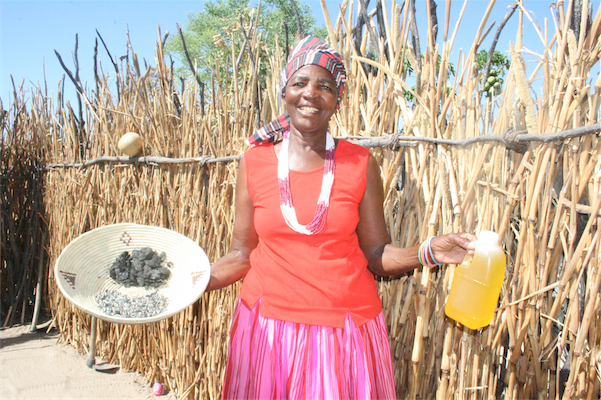Focus area: Adaptation
Website
Location: Omusati, Ohangwena, Oshikoto, Oshana, and Kavango regions in Northern Namibia
Activity established: December 2009
Versión en español
Infographic
The goal of this community-based adaptation programme (CBA) activity to pilot six coping strategies to climate change vulnerability in local communities, with the expectation that these efforts can be duplicated on a large scale to communities in similar situations. The six strategies include: the innovation and use of energy-efficient stoves (the EzyStove), agro-forestry and vegetable production under micro drip. They help sustain food security and income generation with no adverse impacts to the land and other natural resources.
EzyStove, for example, is an fuel-efficient wood-burning stove, developed with local users and Swedish company Veryday. It is produced locally and provides a solution that replaces cooking over an open fire. The stove reduces harmful smoke, decreases deforestation, creates local jobs and drastically reduces carbon dioxide emissions.
The initiative is a response to communities’ concerns over alarmingly high rates of deforestation and increasing respiratory illnesses due to the widespread practice of cooking over open fires.The CBA activity focuses on awareness-building interventions on climate change, coping strategies and nutritional needs, as well as social mobilization of community members. It uses a participatory approach throughout the activity cycle: planning, development, implementation and resource mapping, all to assist in retaining sustainability once the activity is completed.
Self Help Groups (SHGs) were formed as a way for community members to take charge of their own development, savings and lending. Gender mainstreaming and social inclusion approaches are used all throughout the activity to ensure everyone's needs are met and all concerns are addressed. The activity also used a distinctly Namibia-specific method of conservation agriculture, known as conservation tillage (CONTILL).
The activity is already yielding results through its multiple focus areas on adaptation. For example, in June 2010, the first harvest for pearl millet by the Siya SHGs increased from an average of 70kg per hectare to 570kg. In addition, the Siya groups generated cash incomes from their maize harvest and are planning to sell cooking oil they extract from the sunflower harvest.
The Community-Based Adaptation Programme is a five-year United Nations Development Programme global initiative funded by the Global Environmental Facility within the Small Grants Programme delivery mechanism.
The UN Volunteers partners with UNDP and GEF/SGP to enhance community mobilization recognize volunteers’ contribution and ensure inclusive participation around the activity, as well as to facilitate capacity building of partner NGOs and CBOs. In addition, funding is provided by the Government of Japan. The CBA’s goal is to strengthen the resiliency of communities to address climate change impacts. The programme is piloted in Namibia, Bangladesh, Bolivia, Guatemala, Jamaica, Kazakhstan, Morocco, Niger, Samoa and Viet Nam.

The CBA activity also piloted the diversification of seed and new types of
agricultural produce. Many participants piloted sunflower for cooking oil
and chicken feed.
Mitigation / Adaptation
EzyStove is designed according to the wishes of Namibian women and is user-friendly and easily assembled. Since it is fuel-efficient, it lessens women’s burdens by reducing fuel wood consumption by two thirds, while simultaneously cutting back wood smoke emissions by between 60 and 80 percent. Users have reported on a cleaner cooking environment when using the EzyStove since it vastly reduces smoke and soot emissions, thus creating less indoor air pollution.
Social and economic benefits
For women, the EzyStove greatly contributes to and enhances women’s roles in the community since they will now have more time to attend to other daily urgent matters.
Through the method of conservation agriculture, food shortages have been lessened.
In addition, the CBA activity's sustainable practices are integrated into the school’s syllabus, reaching young people as they learn about climate change, its impacts, conservation agriculture for dry land crops, soil improvement techniques and micro drip irrigation of vegetables. The activity is assisting schools to reach the intended objectives of life science, adaptation and agriculture.
Potential for scaling-up and replication
The activity aims to influence policy at the local and national level. It has been advocated by His Excellency Hifikepunye Pohamba, President of the Republic of Namibia. During a visit to an activity site in 2011, President Pohamba was impressed with the CBA activities and local participation, stating that the activities "are heading towards one of the most promising agriculture/adaptation activities in the country."
Lessons learned and sustainable adaptive practices are replicated by neighboring communities, as well as other government institutions and non governmental organizatoins. As a next step, Namibia's Environmental Investment Fund is funding a pilot to carry out EzyStove usage in Katutura - the densely populated township on the outskirts of Namibia's Capital Windhoek. The Pupkewitz Foundation is co-funding the pilot. This activity will be implemented by CES, who look to carbon offsetting finance to scale up EzyStove production to a volume of two subsidized stoves in each of the 200,000 Namibian households, creating 300 stove assembly jobs.




Images owned by the activity partners, all rights reserved.